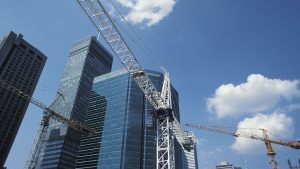A first-quarter survey of Canadian construction executives by the Royal Institution of Chartered Surveyors (RICS) found Ontario stakeholders were more upbeat about the prospects of post-COVID recovery than in the rest of the country.
The survey was sent out on March 11, just as the reality of the COVID-19 pandemic was starting to dawn on Canadian constructors, and responses were received until April 16.
The Q1 2020 Canada Construction and Infrastructure Survey from RICS and the Canadian Institute of Quantity Surveyors found that “despite a huge array of government fiscal interventions (worth in the region of 14 per cent of GDP), the recovery process is likely to prove quite protracted.”
Although Ontario construction seemed to be in a “holding pattern,” RICS chief economist Simon Rubinsohn explained, with respondents reporting little initial change in new business enquiries, new workloads and headcount, there were warning signs looking into the future with stakeholders expecting profit margins to take a hit.
“Workloads are anticipated to remain subdued over the next 12 months, with employment projected to drop and, most notably, profit margins viewed as coming under pressure,” the survey reported.
“It is a function of the uncertainty,” Rubinsohn said about profit margins. “I think that is inevitable given the uncertain economic environment and what that means in terms of delivering (projects) in any area of the market. There is a lot of uncertainty about how that delivery will be executed and what costs are going to be incurred.”
The survey found Ontario stakeholders expected infrastructure workloads to slightly increase in the next 12 months, other projects to remain flat, workforce to dip slightly and profit margins to fall significantly.
Those trends, as equivocal as they are, were more positive than elsewhere across Canada, Rubinsohn noted.
“The takeaway would be that there are still opportunities,” he said, calling Ontario “resilient.”
“While it may be a little bit tougher going forward, that is the case across the economy and across the globe… So against that sort of background, I think there are still going to be opportunities for investors.”
Major factors expected to hold back activity in Ontario besides a labour shortfall included shortage of materials, lack of demand, financial constraints and cost of materials.
In fact, 12-month expectations of hikes in tender prices and construction costs were highest in Ontario compared with other provinces and territories and higher than most regions of the U.S.
Tender prices on building projects were expected to rise 3.4 per cent and on civil engineering projects to spike 3.1 per cent. Construction costs are expected to hike 3.2 per cent in the next 12 months in Ontario, topped only by the U.S. south.
Rubinsohn said he had doubts whether those expectations will be the same after the end of the next quarter.
“I will be interested to see if those numbers change over the next three months because we are moving into a period where there is a shift around the dynamics of construction, and we see this whole cloud of COVID hanging over the economy.”
With a slowdown reported in the first quarter and expectations it would continue, stakeholders across Canada predicted that workforce shortages would be less of a problem than in 2019 — but it remains an issue to some. The proportion of respondents indicating concerns about the availability of skilled workers has dropped from over 60 per cent to less than 50 per cent since the fourth quarter of last year, and for the wider category of labour, it has slipped from just under 60 per cent to close to 40 per cent.
The fact that a labour shortage still exists means there will be upward pressure on project costs, which in turn could be another factor preventing the recovery from firing on all cylinders, Rubinsohn said.
The lack of skilled trades will remain an issue despite the current loss of headcount, he remarked.
“I don’t think it is something we can take any comfort from because there are better ways to address a problem than a fall in demand or a crash in the economy.”
Follow the author on Twitter @DonWall_DCN.











Recent Comments
comments for this post are closed